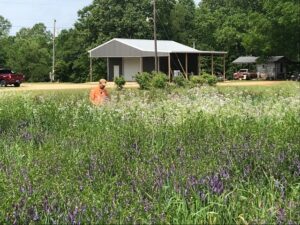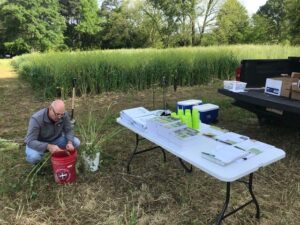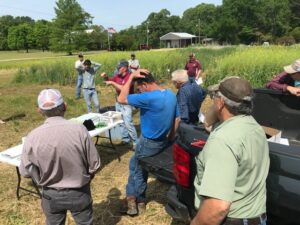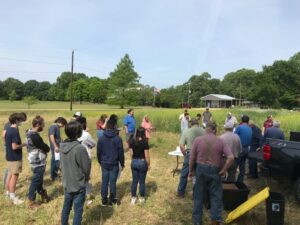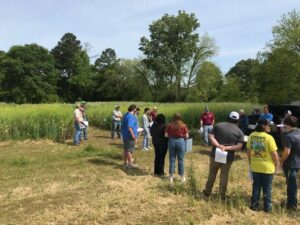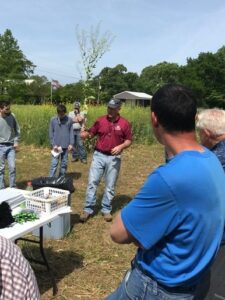Final report for ES20-153
Project Information
Sweet potato production requires soil have low bulk density to produce high quality roots for the fresh market. To loosen soil, Mississippi producers conduct up to 12 tillage operations per year which extends into the off-season. Cover crops can reduce soil erosion while improving tilth, scavenge nutrients and provide nitrogen fixation. Producers often reject cover crop benefits since they are not harvested and sold. CoverItUp is a 2-year Train-the-Trainer program to educate trainees on cover crop benefits, specie selection, establishment and crop termination methods, and management tactics. Project will target Extension agents, USDA-NRCS, Experiment Station staff and Mentor Farmers. Mentor Farmers hosted on-farm plots and field days. Long term goals are: 1) reduce soil erosion via cover crops, 2) education of soil health benefits by sustaining live roots throughout the year, 3) lower fuel demand through reducing tillage, 4) establish a local network of professionals competent in cover crop management. Specific objectives are: A) increase trainee knowledge of cover crop benefits, B) improve knowledge of specie selection, C) increase awareness of crop establishment and termination tactics, D) educate on strengths and weaknesses of specie mixtures, and E) realize cost savings through low-intensity implements. Primary activities are: a) demonstration plots/field days, b) fact sheets and publications, c) in-service training, d) mass and social media, e) local, regional and national presentations. Five field days were held at four locations with 204 attendees (44 Extension agents, 27 NRCS staff, 4 Mentor Farmers, 68 producers, and 61 high school Ag students). Outcomes were measured using attendance, authored publications, and sweet potato acres protected by cover crops.
The primary target audience was Extension Agents from Mississippi State University, Alcorn State University, NRCS staff, mentor farmers, and other farmers. Mentor farmer adoption was a huge factor is convincing other producers that cover crops can lead to long-term soil health success.
A multi-disciplinary team of Specialists educated “trainers” and producers who will disseminate information at the county level. Trainees received knowledge, hands-on experience, resources and technical support to help sweet potato producers’ move from hearing about cover crops to utilizing them.
Long-term goals are:
1) Reduce soil erosion in fields left vulnerable during the winter months
2) Educate producers of soil health benefits of sustaining living root systems throughout the year
3) Develop a network of professionals competent in cover crop management
4) Lower fuel demand through reduced tillage
Project Objectives are to:
1) Increase trainee knowledge of soil health and reducing erosion via cover crops
2) Increase proficiency in species selection and placement
3) Increase knowledge of crop establishment (seeding rates, planting method) and termination methods
4) Educate trainees on strengths and weakness of various seed mixtures
5) Develop awareness of weed/pest suppression and potential for pest issues (green bridge)
6) Increase awareness of sustainability through reducing inputs (lower fuel consumption with cover crops vs tillage)
Objectives 1 – 6 addressed using similar tactics and programs. We worked with four Mentor Farmers to showcase the value of cover crops. The PI has worked with both Mentor Farmers on other projects and they were excited to host field days showing the value cover crops offer. All farmers have incorporated cover crops and are proponents of the practice. We established demonstration plots and hosted field days in spring of 2021 and 2022.
Objective 1 focused on general knowledge of benefits and how to reduce erosion. We provided 2 hours of classroom training followed by 2 hours in-field training at field days. This was led by PI and assisted by Dr. Beth Baker. Dr. Baker and I often present together at other field days and our presentations are complimentary. Dr. Baker demonstrated water flow hydraulics, erosion potential and sediment losses/capture. She showed the importance of reducing erosion whereas I demonstrated erosion using a 5-pan erosion simulator. The simulator is an excellent visual learning tool. Trainees saw how to reduce erosion losses with cover crops and realize the benefits of a continuous living cover on microbe activity, compaction reduction and water infiltration.
Objective 2 addressed proper specie selection. Demonstrations showcased 40 plots of specie in various mixtures. Trainees saw the benefits and limitations of each mixture and its relationship to sweet potato production. Issues like rooting structure, nodule formation, biomass production, and insect infestations were reviewed. Trainees witnessed the positive and negative aspects of specie mixtures and how to select the proper species.
Objective 3 addressed establishment and termination methods. Trainees received classroom training and publications before visiting demonstration plots. We used a split-plot design with main plots being establishment method (grain drill vs broadcast) and split-plot being with and without cultipack. Attendees learned how seeding method affects costs, plant growth and benefits received. Attendees were taught crop destruct methods including herbicide desiccation, roller/crimper and disc. Trainees learned positive and negative aspects of each planting and crop destruct method.
Objective 4 addressed strengths and weaknesses of seed mixtures. Demonstration plots provided visual learning of how species interact with one another. Trainees learned how to evaluate seed cost expenses, effects of soil type, innoculants, differing planting depth per specie, and what benefits (reduce erosion, nutrient recycling, water infiltration, nitrogen fixation, pest/weed suppression) each species can deliver.
Objective 5 addressed weed/pest suppression and pest sanctuary (green bridge). Trainees learned how some cover crops can suppress weed species through light reduction and allelopathy such as black oat suppressing nematodes (major pest in sweet potato). Trainees learned how cover crops must be managed properly to lessen pest issues in the cash crop (green bridge).
Objective 6 educated trainees and producers on reducing tillage operations via cover crops to lower fossil fuel demand. Trainees were taught how cover crops can reduce bulk soil density and weed populations thereby reducing tillage operations. Cover crops were shown to be cost-effective in improving bulk density and thus reducing tillage passes.
Cooperators
- (Educator)
- (Educator)
- - Producer
- - Producer
Education
Field Days using demonstration plots were the primary source of education used. Multiple locations increase attendance by growers. Additionally, I entertain individual producer, NRCS and Extension agent questions and hosted two state-wide in-service trainings in 2021 and three trainings in 2022. Participants at each training received educational publications in addition to in-the-field education while viewing 40 demonstration plots.
Education & Outreach Initiatives
Introduce and/or expand knowledge of cover crops benefits and limitations in reducing erosion and improving soil health in sweet potato fields.
Five field days were held to highlight cover crop usage. Positive and negative aspects of species and techniques were provided. Field days were April 22, 2021 (Chickasaw county), April 27, 2021 (Monroe), November 4, 2021 (Pontotoc), March 22, 2022 (Pontotoc), and March 29, 2022 (Calhoun). A total of 204 attendees participated in the five events. Field days were scheduled to last 4 hours each but lasted 5+ hours as interest was higher than expected and the question/answer portion was extended. A diverse group of Extension agents, NRCS field staff, consultants and farmers participated.
Major topics discussed were: 1) rationale for cover crops, 2) potential benefits for erosion, soil health, nutrient recycling, tilth, etc. 3) specie selection based on needs, 4) costs per acre, 5) establishment practices, 6) termination practices, 7) Green bridge insect issues, and 8) nitrogen fixation. There was very high interest in selecting the proper grass specie and planting rates as well as critiquing clover species for soil type, nitrogen fixation potential and termination issues.
Each attendee received a Hori soil knife in the hope that a convenient digging tool encourages more pro-active learning on their own fields. Participants were impressed with the tool and indicated a strong likelihood in more routine checks of root systems.
Multiple crop consultants attended and showed a desire to recommend covers to their clients. Consultants, in conjunction with Extension, has great potential to convince producers to utilize covers. Mentor farmers were very positive and provided actual benefits they have witnessed on their operations following cover crops. One consultant emailed after the final field day saying, ".... seeing the same species growing across a range of environments on different years really helps us learn the ins and outs of these plants, and what to expect when we recommend them to clients".
Educational & Outreach Activities
Participation Summary:
Learning Outcomes
Project Outcomes
Two-hundred and four individuals (72 producers and Mentor Farmers) attended the five Field Demonstration Days. All attendees were receptive to using or recommending cover crops and approximately 15% of attending producers had used covers to some extent in the past. Discussion and question periods were robust as agents, consultants, producers queried me on a myriad of topics. Attending producers/consultants were surveyed in fall of 2021 and 2022 to determine adoption rates.
The main outcome was producers, consultants, and agents becoming more knowledgeable with cover crop benefits and limitations. As knowledge increases, learners become more comfortable in asking questions and devising a cover crop farm plan. One mentor farmer now uses cover crops on 100% or his organic sweet potato acreage. He also plans to use summer cover crops in his fallow year. A second producer indicated his plan to use cover crops on a majority of sweet potato acreage. These two influential producers will lead others to follow in their footsteps.
Producers and agents were appreciative of seeing the 40 demonstration plots. The plots allowed producers to see how different species interact with each other. How one can supplement or antagonize another. This hands-on activity affirmed to learners the potential of cover crop tactics in improving soil health and reducing expenses in the long-term.
Extension agents, consultants, and NRCS field staff now have multiple reference materials to use in recommending cover crops to their clients.
Following one field day, a consultant who is highly influential in the Mississippi sweet potato industry sent me an email thanking me for the program. His email included, "glad I was able to make it. Seeing the same 8-10 species growing across a range of environments on different years really helps us learn the ins and outs of these plants, and what to expect when we plant them or recommend them to clients". The multi-year, multi-location demonstration plots allowed this consultant to build a 'real-world' knowledge base upon which he is more comfortable recommending cover crops to his clients.
I have Extension and research appointments which are not always complimentary. Research plots are necessary however, demonstration plots are more likely to lead to grower adoption. Growers are reluctant to believe data from small plots, but demo plots make a lasting impression and 'get the point across'.
